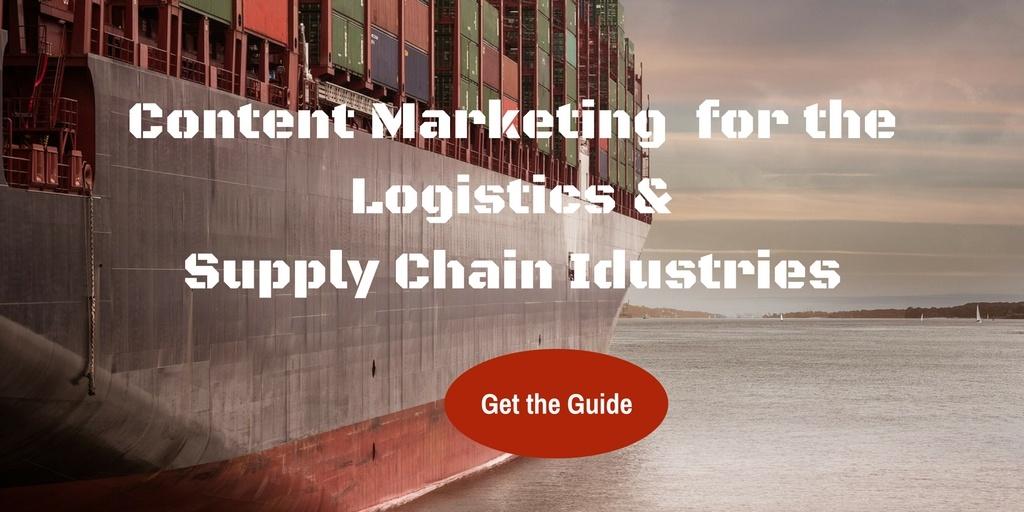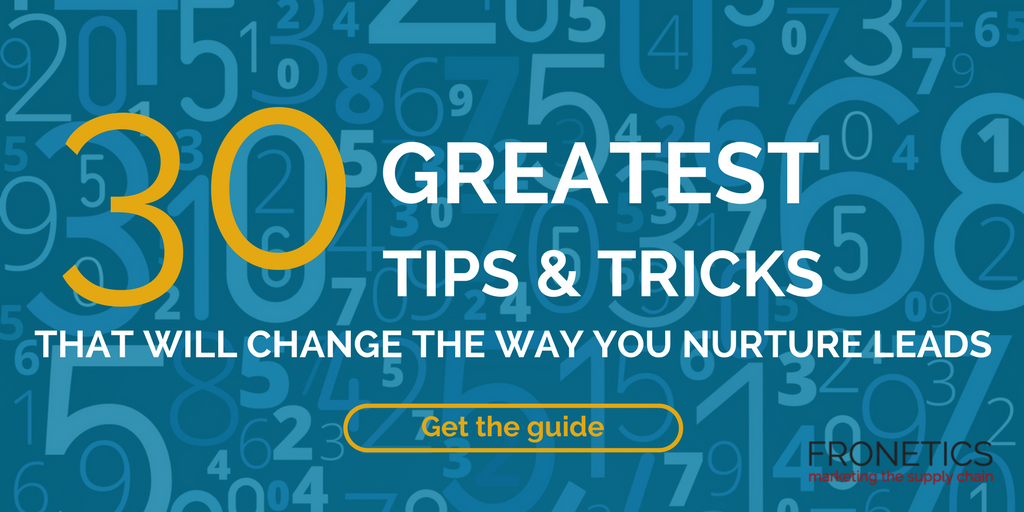


Using Analytics to Align Sales and Marketing Teams
Supply chain companies are increasingly recognizing the need to align sales and marketing teams through the use of analytics.
Highlights:
- Sales and marketing alignment can be aided by analytics tools.
- A content audit can ensure sales has relevant material for every stage of the buyer’s journey.
- Digital Asset Management Software acts as a unified repository for content and analytics data.
Often, when we first talk to prospects about digital marketing, their sales teams start to get the jitters. There’s a big misperception out there that inbound marketing is bound to make sales teams obsolete – but this couldn’t be further from the truth. In fact, when companies take steps to align sales and marketing teams, their efforts start to pay off in big ways.
We’ve written a lot about how to align sales and marketing, as well as the dangers that crop up when companies haven’t synchronized these departments. That’s not to say that it’s an easy task. In fact, HubSpot’s 2018 State of Inbound report found that a mere 22% of companies report that their sales and marketing relationship is tightly aligned. Increasingly, supply chain companies are finding success using analytics tools to meet the challenges of aligning sales and marketing teams.
Understand your target audience
If you’re on the marketing side, you probably have a picture of your target audience, including multiple specific buyer personae. But how familiar is your sales team with this information? Chances are, sales has knowledge about your target audience that is based as much on experience as it is on the goals your marketing department created.
If the lines of communication aren’t clear when it comes to understanding your target audience, you’re shortchanging both marketing and sales. The sales department needs clear and complete communication from marketing about the type of buyers being targeted. Meanwhile, the knowledge that sales personnel will have accrued from their on-the-ground experience can help shape future marketing efforts.
To align sales and marketing in their understanding of your target audience, web analytics tools like Google Analytics are extremely beneficial. Use analytics to track user interaction with all your digital assets and build accurate personae that are data-driven. Ideally, analytics can validate and enhance the knowledge that sales teams have built.
Align sales and marketing with content that enables sales in a digital space
One of the most frequent complaints sales teams voice is that they lack relevant materials from marketing. And on the other side of the coin, marketing departments often report that sales teams aren’t clear about their needs, nor do they use the materials they’ve provided.
To get everyone on the same page, perform a content audit to determine which of your existing content matches with each target buyer persona, as well as what content will be most useful to your sales team at each stage of the buyer’s journey. Next, put some analytics in place. You need to know how your content is performing not just from a lead-generation perspective, but from the standpoint of closing deals.
To help you develop a process for evaluating the success of your content and soliciting and incorporating feedback from sales, Digital Asset Management Software is a great resource. Tools like Canto or Bynder can be a synchronized, discoverable repository of marketing assets and their function for sales, as well as help you keep track of your analytics.
Final thoughts
As supply chain companies are increasingly recognizing the need for sales and marketing teams that work in tight alignment, analytics are an invaluable resource for synchronizing efforts across departments. And the possibilities are continuing to expand for what analytics, including artificial intelligence, can do.
Keeping the lines of communication open, and sharing analytics data will help lead to accurate, data-driven buyer personas and an optimally functioning sales team.
Related posts:

Using Digital Marketing to Keep Your Pipeline Full in the Material Handling Industry: Video Short
When it comes to growing your material handling business, digital marketing can set your company apart, capture quality leads, and keep your sales pipeline full.
Highlights:
- Material handling is extremely competitive and faces challenges like rising interest rates, trade policies that are increasingly inhospitable, and a scarcity of skilled labor, among others.
- Blog posts, e-books, tip sheets, guides, case studies, videos, and other forms of content go a long way toward attracting prospects to your digital assets.
- Arming your sales rep with targeted content to share with prospects during specific moments of the purchasing process advances their reputation as a knowledge source.
Last year, the MAPI Foundation predicted an average of 2.8% growth in manufacturing over the next three years, as well as an increase in capital equipment expenditure by over twice that. For makers of material handling equipment like conveyers, lift-trucks, and handling structures, MAPI’s forecast is good news.
As with all aspects of the supply chain industry, material handling is extremely competitive and faces challenges like rising interest rates, trade policies that are increasingly inhospitable, and a scarcity of skilled labor, among others.
For your business to participate in the forecasted global growth, your best bet is a sales funnel that’s consistently filled with quality prospects. But how do you make that happen?
Here’s where content marketing can help.
Digital marketing keeps you visible to your highest quality prospects
In the fiercely competitive material handling landscape, in which potential customers have a wide array of options, marketers face the challenge of visibility within the industry. Setting your business apart from your competition is obviously crucial to cultivating and captivating leads.
[bctt tweet=”Blog posts, e-books, tip sheets, guides, case studies, videos — all these forms of content go a long way toward attracting prospects to your digital assets, building trust, growing your reputation, and, ultimately, converting leads.” username=”Fronetics”]
Perhaps your best strategy for achieving this kind of visibility is content. Blog posts, e-books, tip sheets, guides, case studies, videos — all these forms of content go a long way toward attracting prospects to your digital assets, building trust, growing your reputation, and, ultimately, converting leads.
Generating leads with content
A content-rich site has great advantages in terms of SEO (for more on this, check out our four-part series on writing for SEO), which is key to visibility. Creating quality content and structuring your site effectively will help capture leads. As developing and sharing content attracts prospects to your site, effective calls-to-action (CTAs) drive prospects to share their contact information in exchange for information that has value for them.
Keep in mind when planning and creating your content that your goal is not to push your products — a mistake many material handling marketers make. Instead, use your content to demonstrate to prospects that you have a deep understanding of their business and the unique needs and challenges they face. Offer useful information for each stage of the buyer’s journey. Remember, the most valuable asset you have to offer is your knowledge and expertise.
Align content with sales
Keeping your sales pipeline full is your goal when it comes to competing in the material handling marketplace. Arming your sales rep with targeted content to share with prospects during specific moments of the purchasing process advances their reputation as a knowledge source. That can be the key to getting a foot in the door, advancing through the final stages of a purchasers’ decision, or closing the deal.
When digital marketing and sales work together, you’ll see the results hit your bottom line. Curating and creating great content will generate quality leads for your company. And it also empowers your sales force to build relationships with potential customers — and close the sale.
Related posts:

Top 5 Sales and Marketing Posts 2018
Aligning sales and marketing can help achieve big-picture goals. Here are the top five sales and marketing posts of 2018 that highlight how these two teams can work together.
The sales process is often a complicated journey that includes uphill climbs and unexpected roadblocks. Sales teams are all too familiar with these obstacles, but they don’t have to fight these battles alone.
Arm a sales rep with targeted content to share with prospects during specific moments in the purchasing process, and it will build his or her reputation as a knowledgeable resource. That can be the key to getting a foot in the door, advancing through the final stages of a purchasers’ decision, or closing the deal.
[bctt tweet=”Arm a sales rep with targeted content to share with prospects during specific moments in the purchasing process, and it will build his or her reputation as a knowledgeable resource. ” username=”Fronetics”]
Strong communication between sales and marketing can help create better content and nurture leads. Here are our top five sales and marketing posts of 2018.
Top 5 sales and marketing posts 2018
1. Infographic: the B2B Buyer’s Journey
Technology has completely changed the B2B buyer’s journey. The vast amount of information available on the internet has afforded buyers a level of self-sufficiency that renders traditional sales models ineffective. Marketers must leverage the latest trends and technologies to boost their content marketing efforts and turn leads into sales. Here are nine factors affecting today’s B2B buying journey. Read full post
2. Infographic: How Digital Natives are Changing B2B Purchasing
Long gone are the days of men and women sitting around a conference table listening to a sales pitch over a free lunch. Today’s B2B buyers are younger, more technologically savvy, and more independent — they’re a generation of digital natives. And they’re making waves across the B2B buying landscape and changing how marketers must work to reach new customers. Here’s what you need to know about the new B2B buyer. Read full post
3. The 3 Most Important Sources of Information for B2B Buyers
From a content marketing perspective, knowing where your buyers get their information is critical to an effective strategy. So what are most important sources of information for today’s B2B buyers? 20 years ago, you might have named things like product info sheets or sales reps. But not anymore. Read full post
4. 3 Dangers of Sales and Marketing Misalignment
Too often, B2B companies fall victim to the dangers of sales and marketing misalignment, often without even being aware that it’s an issue. Such misalignment can have serious motivational and financial consequences. These are the major dangers of sales and marketing misalignment compared to what can happen when things go right. Read full post
5. Infographic: Delivering Content Throughout the Buyer’s Journey to Help Your Sales Team Close Deals
If you’re a supply chain marketing professional, it’s likely that you spend a tremendous portion of your day researching, creating, packaging, and disseminating content. It’s time to start leveraging your it throughout the buyer’s journey by arming your sales force with content. Before you panic at the idea of creating reams of new content, take a breath. It’s more than likely that you can repurpose your existing content, optimized to give your sales force the tools they need to close deals.Read full post
Related posts:

How to Market to Your Millennial B2B Buyers
Companies can reach millennial B2B buyers by partnering with popular social media users who speak with passion and expertise to young professionals.
Numbering 80 million, millennials have become the largest demographic segment in the United States and are expected to command more than $1 trillion in disposable income by the year 2020. As this generation comprises an increasing percentage of the B2B buying landscape, businesses must pay attention to their professional purchasing habits — which, it turns out, bleed over from their personal purchasing patterns.
Millennials are notoriously hard to reach through traditional marketing strategies. But successfully appealing to that demographic is becoming more and more important. Jay I. Sinha and Thomas T. Fung, marketing specialists at Temple University, explain how B2B companies can use “nano-marketing” techniques to generate buzz and build credibility with millennials.
Micro-influencers
Large companies have traditionally used celebrities and recognizable logos to promote their brands. But millennials have turned away from advertising and endorsements that aren’t perceived as authentic or based on expert knowledge.
Millennials have led a surge in the popularity of social media platforms, and companies have found increasing success in using sites like Instagram, Snapchat, Pinterest, and YouTube to market to this demographic.
[bctt tweet=”“Micro-influencers,” or social media users whose followers number between 1,000 and 100,000, have proven four times more likely to generate viewer engagement over the products they review than celebrity endorsements.” username=”Fronetics”]
“Micro-influencers,” or social media users whose followers number between 1,000 and 100,000, have proven four times more likely to generate viewer engagement over the products they review than celebrity endorsements. Partnering with micro-influencers is a highly affordable way for companies to make their brands visible and relatable.
Micro-influencers have helped turn start-ups into major brand-names and have helped established companies extend their influence into youthful markets, leading Inc. magazine to declare 2018 the “Year of the Micro-Influencer.”
Strategies for B2B companies
Sinha and Fung argue that this strategy is not just for B2C companies selling products known to appeal to millennial consumers. What’s known as nano-marketing, or partnership with micro-influencers, can be just as effective for B2B.
Sinha and Fung offer four managerial guidelines for B2B companies seeking to partner with micro-influencers.
1. Micro-influencers have specialized and self-selecting audiences.
Picking the right micro-influencer to partner with can help you target the sub-groups you want to reach. For instance, GE uses nano-marketing to help recruit female tech professionals.
2. Recognize the strengths of micro-influencers.
They make products and companies seem relatable to viewers by sharing their personal experiences. Companies can leverage this in their branding.
3. Nano-marketing works best as “a subtle nudge.”
Whereas traditional advertising has to be heavy-handed to be memorable, micro-influencers speak with credibility about brands that they personally have used.
4. Entertainment.
Micro-influencers find innovative ways of producing content that will appeal to their followers and incorporate their brand endorsement in creative formats.
Millennial B2B buyers should be an increasing focus of your targeted marketing activities — if they’re not already. How are you reaching this audience?
Related posts:




